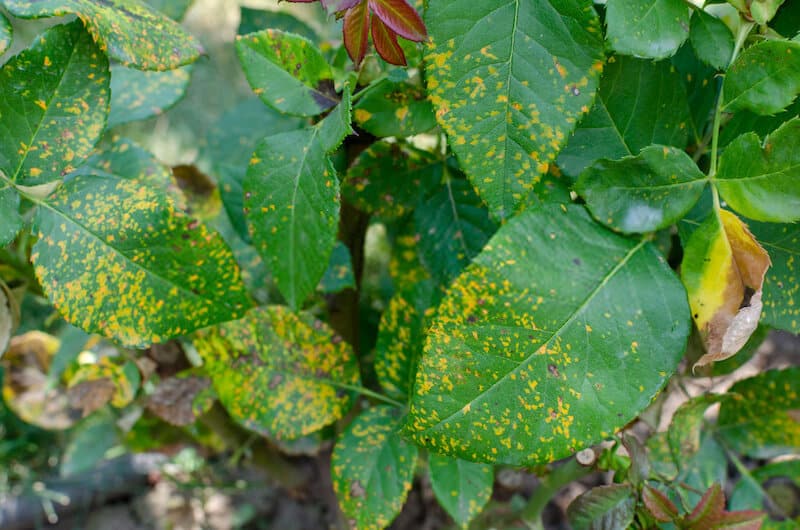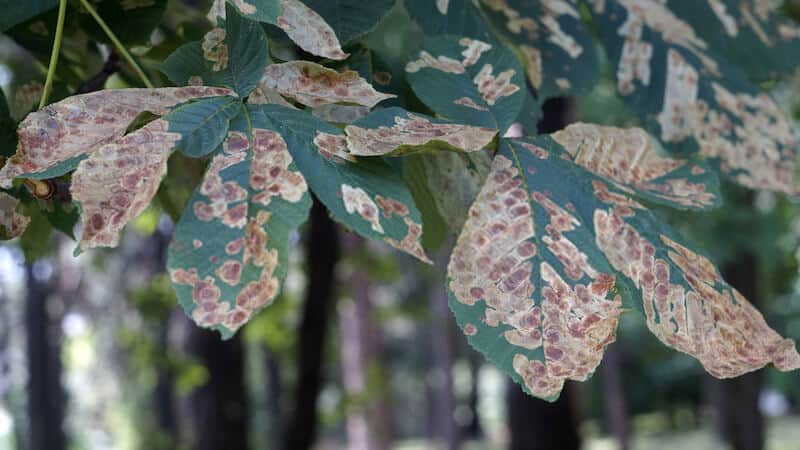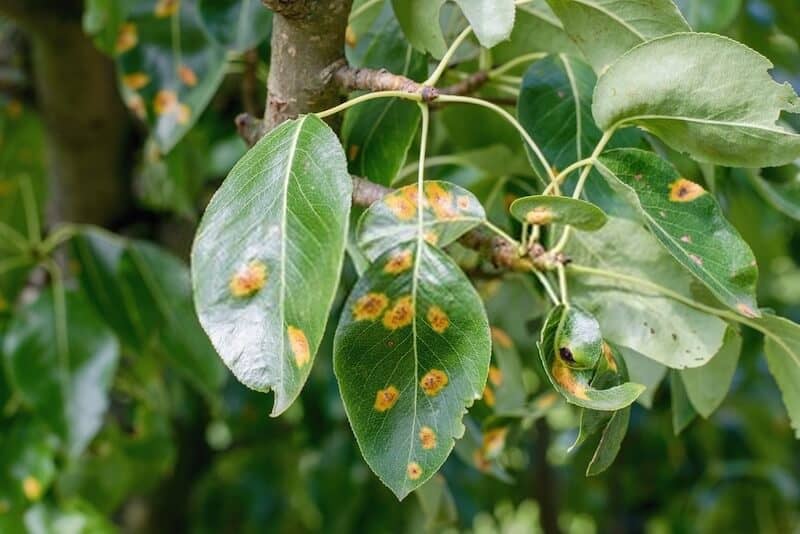Have you noticed a white powdery film on plants around your home recently? If your answer is yes, you might be dealing with white fungus infestation.
This fungus is relatively common and covers leaves/stems of plants. Although it may appear harmless, you should remove it.
If left untreated, it causes more harm to plants ranging from the inability to convert sunlight to energy, reduced attractiveness, and plant yield. Some severe cases even result in plant death.
In this article, we will show you how to get rid of white fungus on plants and how to prevent their growth.
Table of Contents
What Is White Fungus?
White fungus is caused by Podosphaera xanthii, a fungal pathogen. This fungal disease produces a fuzzy white film that covers plant stems and leaves. It creates microscopic spores from the plant’s surface that are air-borne.
These spores are high in water content and can infect plants even in drier seasons than other fungal pathogens. It usually affects different young, growing plants like vegetables, fruit trees, bushes, and ornamental plants.
The life cycle of this disease begins in summer and spans through autumn and spring seasons. As a result, you must know how to get rid of white fungus on plants to prevent re-infestation.
What Causes White Fungus on Plants?

This fungus disease forms on plants under the following conditions:
- Dry plant foliage.
- Warm temperatures between 60oF – 80OF (15oC – 26oC).
- Inadequate sunlight.
- High humidity.
- Poor circulation of air.
When the fungus grows, air assists in spreading the spores to other plants. Also, watering plants in the afternoon increase the humidity levels at night, thereby increasing the chances of spreading the spores.
Which Plant or Vegetable Is Most Prone to White Fungus Infestation?
The following are some plants that are prone to white fungus infestation:
- Roses
- Sunflowers
- Dahlias
- Begonias
- Chrysanthemums
- Zinnias
Some examples of vegetables and fruits affected by this disease are cucumbers, pumpkins, peppers, tomatoes, grapes, and parsley. Others include pawpaw, apples, melons, strawberries, lettuce, and potatoes.
Note: This list is not all-inclusive. So, you must check your plants regularly for signs of white fungus growth.
How to Get Rid of White Fungus on Plants
The first thing to do is to prune affected plant foliage, including flowers, leaves, fruits, and branches. Then clean all fallen debris around the plants. After cleaning, burn all the pruned plants and waste. Pruning will reduce the severity of the fungus considerably.
There are two methods of treating white fungus on plants:
- Natural methods
- Chemical methods
Removing White Fungus On Plants Naturally
The following are natural methods of removing white fungus from plants:
1. Neem Oil
This oil is produced from fruits and seeds of the neem tree. It is a powerful remedy that can kill the fungal disease within 24 hours. Neem oil interferes with the plant’s metabolism, stopping the production of spores in the process.
Directions
Mix 3 tablespoons neem oil to water (1 gallon). Pour this solution into a spray bottle. Then spray it on the affected plants. Precautions must be taken to avoid spraying neem solution on the plant’s flowers and buds or sunburning the leaves.
2. Garlic
Garlic is a potent natural fungicide with high sulfur content.
Directions
- Crush 6 garlic cloves.
- Add the crushed garlic to 1 ounce of rubbing alcohol and neem oil. Then leave it to sit for two days.
- After that, strain and keep the liquid.
- Soak the crushed garlic again in water (1 cup) for one day.
- Strain the liquid and discard the used garlic.
- Add the garlic liquid to water and spray the plants. Make sure you coat the leaves only.
3. Milk
Studies have shown that milk is an effective fungicide compared to other chemical fungicides. Other studies have proved some anti-fungal activity in natural milk gotten from cow, goat, or ewe.
Although researchers are not so sure why natural milk is significant, they believe it is a result of its interaction with sunlight, which produces some free radicals. These free radicals are said to be very harmful to white fungus.
Directions
Mix 40 parts milk with 60 parts of water. Spray this on the affected plants twice every week. Alternatively, mix 2 liters of water with 1 oz. Powdered milk and spray this solution on the diseased plants twice every week. You can also use whole undiluted milk (without diluting it with water) for a more substantial effect.
4. Water
Watering plants can help to get rid of white fungus since dry conditions and high humidity are contributing factors. However, you must ensure that you do this sparingly. Overwatering your plants can do more harm to the plants than good.
Removing White Fungus on Plants With Chemical
1. Baking Soda
Bicarbonate of soda (pH value of 9) creates an alkaline condition that kills white fungus—mix ½ teaspoon of liquid soap, water (1 gallon), and one tablespoon baking soda. Then spray the baking solution on the affected plants.
Note: Don’t apply this solution during the day. You should test 1 or 2 leaves to check if it will bleach the plant.
2. Vinegar
Vinegar is a powerful fungicide, but care must be taken not to mix the concentration of the solution too strong. The reason is that its acetic acid content can burn the plant.
Mix water (1 gallon) and four tablespoons of vinegar and then apply this solution on the plant leaves. You can reapply after three days.
3. Potassium Bicarbonate
Potassium bicarbonate with a pH of 8.3 kills spores on application. It creates an alkaline environment unsuitable for fungal growth.
Mix vegetable oil, ½ teaspoon soap, and three tablespoons of potassium bicarbonate in water (1 gallon). Spray this solution onto the affected plants.
How to Prevent the Growth of White Fungus on Plants
The most economical method of getting rid of white fungus on plants is to prevent its growth and spread. One way is to plant fungi-resistant species. Here are other steps you can take below:
- Create a space between your plants to ensure there is sufficient airflow.
- Put plants in areas they will get enough sunlight.
- Boost the nutrient levels in the soil by using compost. High nutrient levels will also increase the population of beneficial microorganisms.
- Do not fertilize your plants as new growth are susceptible to fungus infestation.
- Remove diseased or dead stems and foliage to maintain your plants properly.
- Be sure that the soil drains properly so that the earth does not become a breeding ground for organisms that cause diseases.
- Do not splash water directly on plants. Instead, sprinkle water on the soil using a garden hose.
- Prune your plants often to reduce humidity and improve air circulation.
Conclusion
White fungus is a fungal disease that affects the stems, foliage, flowers, and fruits of plants. You need to know how to get rid of white fungus on plants effectively once it appears, and the best way is to prevent its development in the first place. Failure to do this can expose the plants to more damage.
Please make sure you properly remove the fungal spores to stop its spread to other plants.
Finally, get fungi-resistant plant varieties. Getting one will save you a lot of money and time you would have used to remove the fungus and stop its spread.






